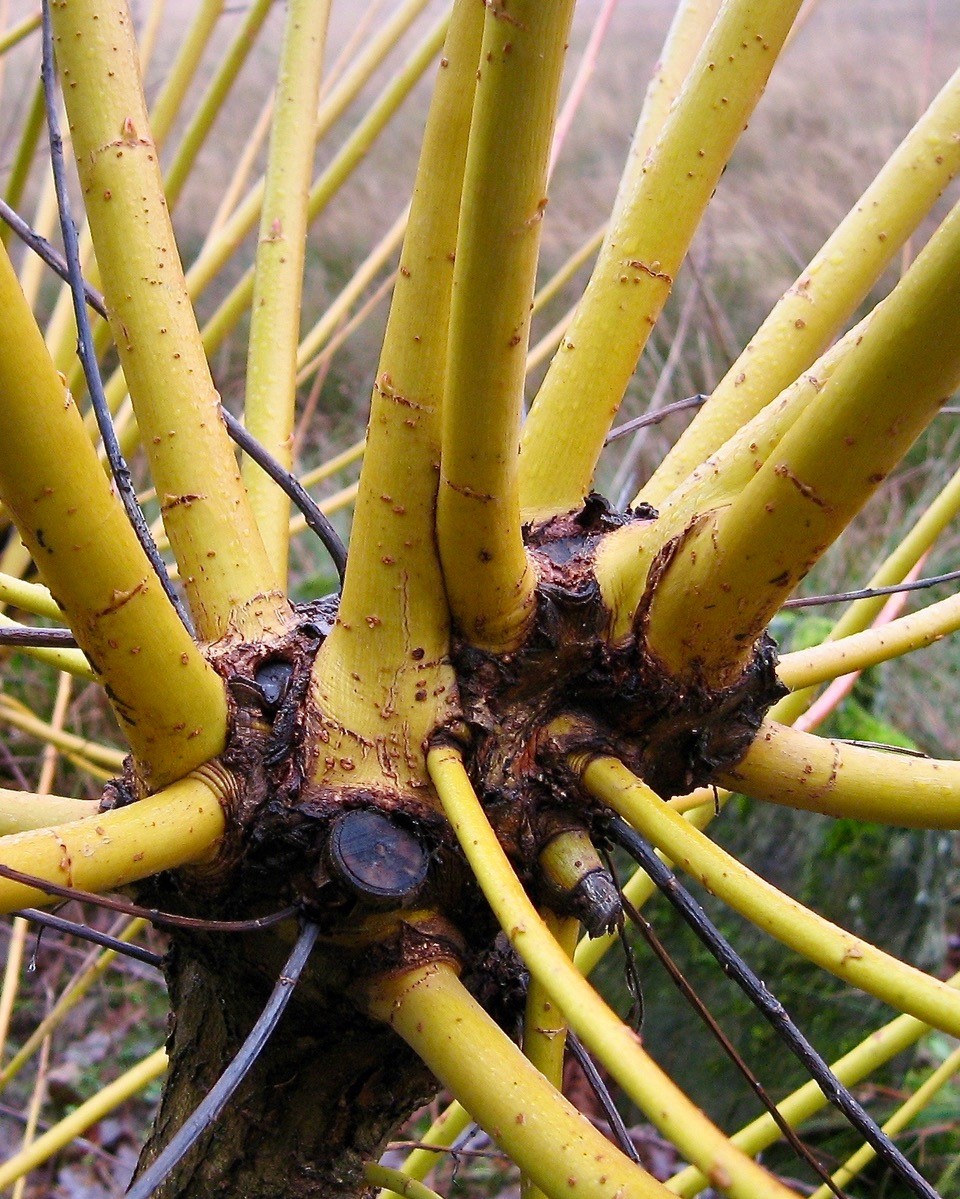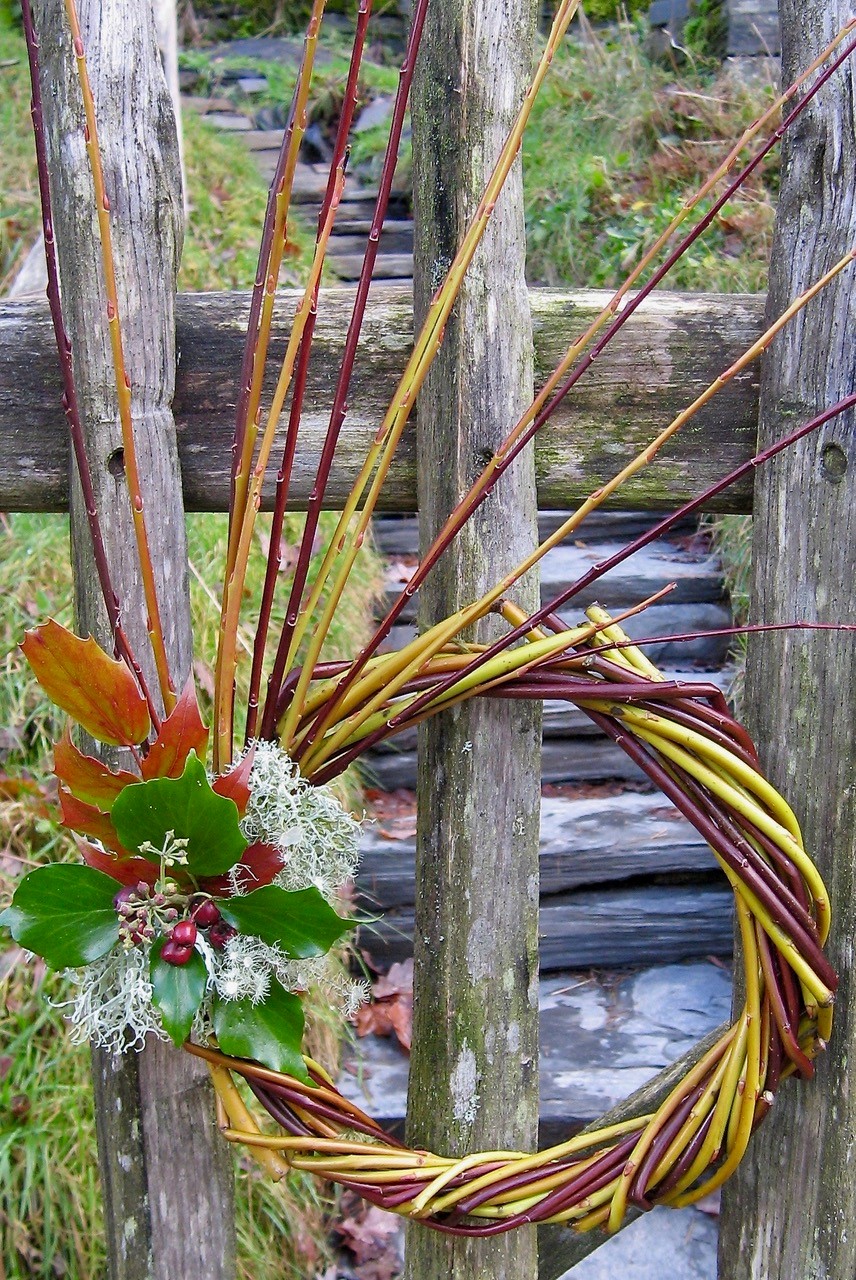Weave magic with willow, for seasonal cheer without an entwined ecological cost.
Bar a few rare leaps, my heart is apt to sink at this time of year. Often, it quietly howls, when bemusement turns to anger, then despair. I know it doesn’t sound like I’m brimful of seasonal spirit – winter solstice or Christmas; take your pick – but stay with me.

The one thing to guarantee that my inner howls become audible (think pained groan) is the sight of a traditional wreath. These are often made with a base of dark conifer foliage, and perhaps some berry-less holly, and decorated with plastic holly berries, plastic mistletoe, and – I will scream here, especially if glitter is involved – plastic poinsettias. Garish cheap plastic bows don’t make me so jolly, either. Nor do some of the price tags.
Sometimes it’s worse: the whole wreath is set on a circle of florists’ (plastic) foam, which has zilch going for it ecologically. It produces microplastic pollution, doesn’t rot down in a compost heap or bin… the list goes on. Wire bases are at least reusable and eventually recyclable, and don’t pollute. I guess plastic berries will keep indefinitely, stay red forever, and the blackbirds won’t (hopefully) scoff them. But December is almost always (sudden strikes of severe weather aside) a time of immense, modest riches in our gardens. Colour, texture and form – all of it alive, kicking, tough and adaptable – abound. The potential for giving plastic the seasonal heave-ho is limitless. I’ve given it the boot; I planted colourful-stemmed willows (Salix) instead.
My wonderful, tough, hardy, grow-anywhere, simple-to-prune, undemanding, loved-by-aphids, creative, colourful-barked willows, planted as dormant 1.2m (4ft) cuttings (from The Willow Bank) five years ago, are now in their prime. Dazzling autumn leaf colour makes way for a crop of whippy shoots, just waiting to be turned into the most rottable, pollution-free, unique, therapeutic-to-make and renewable wreaths going. All I need is some compostable jute twine, secateurs, scissors, my sun-warmed greenhouse to work magic in, and lots of willow shoots.
Here’s how I turn those howls of despair into comforting joy:

1 Cut an armful of one-year-old willow shoots, of varying lengths; longer shoots are needed for larger wreaths. You can use dogwoods (Cornus), or any colourful stems that are flexible enough to bend into a circle without snapping. I also use young shoots of hazel (they come with tight catkins right now), and even larch. These yellow-orange stems are Salix alba var. vitellina, and the dark purple is violet willow (Salix daphnoides).

2 Decide on your wreath’s size. Mine is around 23cm (9in) across, so I needed a 1.5m (5ft) shoot to form the initial circle. Start by bending the shoot to the diameter you want, then gradually weave the rest of it, corkscrew-like, clockwise around the circle (the thicker end of the shoot can be made more pliable by bending it before you start). To stop the circle unravelling, use twine to bind the shoot ends together where they meet.

3 Use the bound part of the circle as a reference point. Holding it between your fingers, feed a shoot underneath the circle, then bring it up and over, gradually winding it – again, corkscrew-like – around the circle. The end can be tucked in among the other shoots (or snipped off). Then add in another shoot, laying it just ahead of the previous one, following the ‘up and over’ action. Then repeat. The shoots should all twist around in the same direction.

4 Each shoot you add thickens the circle, making it stronger. If you want a solid, circular wreath, the thinner ends of the shoots can be wound into the circle (working anti-clockwise this time), then trimmed off. But I prefer to leave them as they are – flowing free from the mass of tightly-bound shoots – to add movement. You can have really long shoots escaping like this, even from a small circle, or you can trim them back to suit. You choose.

5 I like to enjoy the willow’s beautiful bark, so here I’ve added minimal, found (and compostable) extras: a glowing mahonia leaf, some pale, storm-downed tree lichen, ivy, and some hawthorn berries (an admirable stand-in for suddenly elusive holly). I carefully eased some in between the winding shoots, tying others in place, discreetly, with twine. You can add as much, or as little, decoration as the home-grown riches in your garden (or a friend’s) allow.

6 Waste not: those excess or ultra-thin shoots, plus any trimmings, are easily turned into the most satisfying and sustainable decorations that money can’t buy. Just form mini circles (see above), in a range of different sizes and colours; making tiny ones, just an inch across, helps to calm a stressed spirit. Hung on your Christmas tree – singly, or in chains of three or more – they’ll keep their colour well beyond the festive 12 days. Who needs baubles?

Once the feasting and festivity is done, your renewable wreath – which will still be looking good come January – can live on. Kept dry, it’ll lose its colour, but can be dressed up again, year after year. Or you can shred it, for mulch. Or lose it in a compost heap; the relatively soft, sappy shoots soon rot. Or, if you’re lazy, slip it under a hedge; it’ll crumble away there too.
Don’t despair if you’re feeling all wan and willow-less; there’ll be pliable, persuadable shoots of some sort, somewhere, on someone’s generous patch, which you can get creative with. And if you want to grow your own armfuls of wonderful willow, the time to push some big cuttings into a hole in the ground is now.
Text and images © John Walker
Find John on Twitter @earthFgardener


